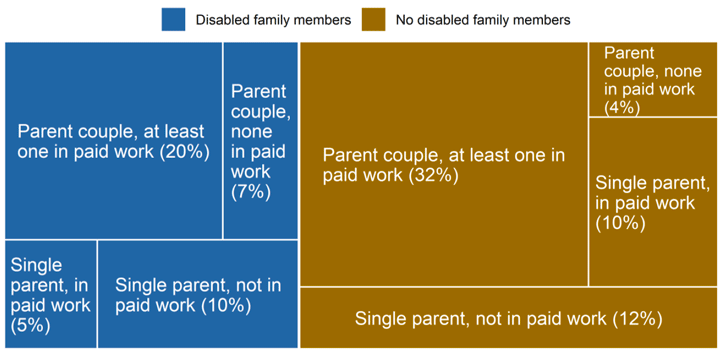Tackling child poverty - third year progress report : annex B - child poverty in families with a disabled adult or child
Evidence about child poverty in families with a disabled adult or child. The report presents the latest data on the child poverty targets and includes further evidence on the drivers of child poverty among this priority group.
Demographics – What We Know about Disabled Families
Around a third of all families in Scotland include at least one disabled member.[3] Most likely the disabled person will be an adult (27% of families), but 11% of families include a disabled child, and in one in twenty families (6%) both an adult and a child are disabled. Just under a fifth (18%) of parents in Scotland are disabled.[4]
Disabled people have very different experiences and encounter different barriers depending on their impairments. Mental health, respiratory and musculoskeletal problems are the most commonly reported impairments among disabled people.[5] Around 0.5% of the population are recorded as having a learning disability although this may be an underestimate.[6] There is limited data on how many people with a learning disability are parents.
Evidence suggests that there is a higher proportion of disabled adults: [7]
- in deprived areas
- in social rented housing
- among those of White Scottish and White British ethnicity (likely to be due to different age profiles of ethnic groups living in Scotland)
- among those identifying as lesbian, gay, bisexual or 'other' sexual orientation, compared to those identifying as heterosexual
- among those in single-parent (than other family) households[8]
- among those who provide unpaid care
- experiencing food insecurity[9]
- who describe their household as not managing well financially.[10]
Data also suggests that disabled people, particularly women, are far more likely to experience domestic abuse than non-disabled people (alongside those of mixed ethnicity and those living in a single-parent household).[11] This may exacerbate some of the difficulties already faced by those in poverty including children.
There is substantial overlap between families with a disabled adult or child and the other child poverty priority groups. For example, 30% of children in households with a disabled adult or child were also in a lone parent household, and 30% were in a household with 3 or more children (2011-18).[12] This intersectionality of characteristics has the potential to compound and exacerbate disadvantage for certain households with a disabled member.
Having a disabled family member often means that other family members take on a caring role. However, children who live in households with an unpaid carer do not appear to be at higher risk of poverty. The relative poverty rates for children who live in households with and without unpaid adult carers are 22% and 25% respectively.
Overall, 42% of children in relative poverty in 2017-20 were in a family with at least one disabled person.[13] Around two-thirds of these were in a family with a parent couple and the other third were in a single-parent family. Many of these families were in work, showing that having any form of paid work is not sufficient to keep families out of poverty – it has to be a sufficient number of hours of adequately paid work.

Graphic text below:
Blue box - Disabled family members
Parent couple, at least one in paid work (20%)
Parent couple, none in paid work (7%)
Single parent, in paid work (5%)
Single parent, not in paid work (10%)
Brown box - No disabled family members
Parent couple, at least one in paid work (32%)
Parent couple, none in paid work (4%)
Single parent, in paid work (10%)
Single parent, not in paid work (12%)
Children in disabled families account for an even higher proportion of those in combined low income and material deprivation – around 58% in 2017-20.[14] This may relate to the additional costs faced by disabled families making some basic necessities harder to afford.
This high level of poverty in the data was reflected in the views of the families we spoke to. Many of the parents we interviewed felt that their financial situation was manageable, but precarious.
"We do manage financially yes because we have to but it's not ideal. But you can't take everything can you, you can't take everything out, I've just got to learn to manage."
Others reported significant struggles with finances, sometimes exacerbated by the pandemic. COVID-19 also appears to have exacerbated food insecurity for disabled people, including disabled parents, as well as having other, wide-ranging impacts on disabled people's lives beyond the significant direct and indirect health and wellbeing impacts.[15]
"We have good months and we have really bad months because there's things you can't budget for, and it's when those things come up that it knocks you off for the future month."
"Life's a struggle. I'm constantly watching the pennies and I'm behind on my rent. I've never been behind on my rent before. I'm trying to get that sorted. It's a struggle."
Contact
Email: sjsu@gov.scot
There is a problem
Thanks for your feedback